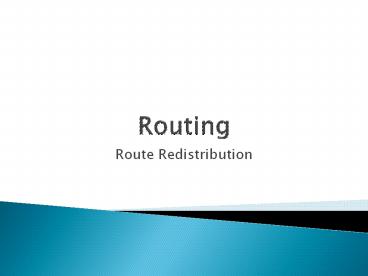Routing - PowerPoint PPT Presentation
1 / 24
Title:
Routing
Description:
RIP 120, OSPF 110, EIGRP ... which is the boundary router that runs both routing protocols and connects ... The figure illustrates a network with RIP and OSPF ... – PowerPoint PPT presentation
Number of Views:252
Avg rating:3.0/5.0
Title: Routing
1
Routing
- Route Redistribution
2
Route Redistribution
- What is route redistribution?
- Why is it required in network?
- Where is it implemented in the network?
- How is it implemented
- Problems due to route redistribution?
3
Complex Routing designs in enterprises
- routing structure of a large enterprise network
typically consists of multiple domains or routing
instances due to - Company acquisitions
- departments administered by different teams
- multi-vendor equipments
- Intentional creation of separate routing
instances to - filter routes
- limit reachability and
- enforce policies
4
Migration
- Careful and thoughtful migration from one
routing protocol to another - The new routing protocol will most likely have
different requirements and capabilities from the
old one. - It is important for network administrators to
understand what must be changed and to create a
detailed plan before making any changes
5
Routing Process
RIP
OSPF
- Routers within one routing instance typically run
the same routing protocol to fully share
reachability information - do not exchange routing information with routers
in other routing instances - Figure 1. It consists of two routing instances.
- Routers in the RIP instance do not have
visibility of the addresses and subnet prefixes
in the OSPF instance and vice versa.
D
A
G
B
F
E
C
H
6
Route redistribution
- Each routing protocol defines a metric for each
route. - RIP 120, OSPF 110, EIGRP - 90
- When a router redistributes routes from one
routing domain to another this information cannot
be translated from one routing protocol to
another. - A RIP hop cannot be dynamically recalculated to
an OSPF cost by the router doing redistribution. - A seed metric is used to artificially set the
distance, cost, etc., to each redistributed
network from the
redistribution point.
7
Default Seed Metrics
Protocol Default Seed Metrics
RIP Infinity
IGRP/EIGRP Infinity
OSPF 20 for all except BGP, which is 1
IS-IS 0
BGP BGP metric is set to IGP metric value
8
Planning Redistribution
- Locate the boundary router between two routing
processes. - Determine which routing process is the core or
backbone process - Determine which routing process is the edge or
migration process - Select a method for injecting the required edge
protocol routes into the core.
9
Example Redistribution into OSPF
RtrA(config) router ospf 1RtrA(config-router)
redistribute eigrp ? lt1-65535gt Autonomous
system number RtrA(config-router) redistribute
eigrp 100 ? metric Metric for
redistributed routes metric-type OSPF/IS-IS
exterior metric type for redistributed routes
route-map Route map reference subnets
Consider subnets for redistribution into OSPF
tag Set tag for routes redistributed
into OSPF ltcrgt
10
Redistributing with seed metric
- Router C is using a seed metric of 30 inside the
OSPF routing process to redistributed RIP routes.
- ROUTER C (config-router) redistribute rip subnets
metric 30. - The link cost of the WAN link to router D is 100.
- The cost for networks 1.0.0.0, 2.0.0.0, and
3.0.0.0 in router D is the seed metric (30) plus
the link cost (100) 130.
11
Redistributing into OSPF
12
Redistributing into EIGRP
- Bandwidth in kilobytes 10000
- Delay in tens of microseconds 100
- Reliability 255 (maximum)
- Load 1 (minimum)
- MTU 1,500 bytes
13
Example Before Redistribution
14
Example Before Redistribution (Cont.)
15
Example Configuring Redistribution at Router B
16
Example Routing Tables After Route Redistribution
17
Example Routing Tables After Summarizing Routes
and Redistributions
18
Example Redistribution Using Administrative
Distance
19
Example Redistribution Using Administrative
Distance (Cont.)
router ospf 1 redistribute rip metric 10000
metric-type 1 subnets network 172.31.0.0
0.0.255.255 area 0 ! router rip version 2
redistribute ospf 1 metric 5 network 10.0.0.0
no auto-summary
Router P3R1
router ospf 1 redistribute rip metric 10000
metric-type 1 subnets network 172.31.3.2 0.0.0.0
area 0 ! router rip version 2 redistribute ospf
1 metric 5 network 10.0.0.0 no auto-summary
Router P3R2
20
Example Redistribution Using Administrative
Distance (Cont.)
21
Example Redistribution Using Administrative
Distance (Cont.)
hostname P3R1 ! router ospf 1 redistribute rip
metric 10000 metric-type 1 subnets network
172.31.0.0 0.0.255.255 area 0 distance 125
0.0.0.0 255.255.255.255 64 ! router rip version
2 redistribute ospf 1 metric 5 network
10.0.0.0 no auto-summary !
hostname P3R2 ! router ospf 1 redistribute rip
metric 10000 metric-type 1 subnets network
172.31.3.2 0.0.0.0 area 0 distance 125 0.0.0.0
255.255.255.255 64 ! router rip version 2
redistribute ospf 1 metric 5 network 10.0.0.0
no auto-summary !
22
Example Redistribution Using Administrative
Distance (Cont.)
hostname P3R1 ! router ospf 1 redistribute rip
metric 10000 metric-type 1 subnets network
172.31.0.0 0.0.255.255 area 0 distance 125
0.0.0.0 255.255.255.255 64 ! router rip version
2 redistribute ospf 1 metric 5 network
10.0.0.0 no auto-summary !
hostname P3R2 ! router ospf 1 redistribute rip
metric 10000 metric-type 1 subnets network
172.31.3.2 0.0.0.0 area 0 distance 125 0.0.0.0
255.255.255.255 64 ! router rip version 2
redistribute ospf 1 metric 5 network 10.0.0.0
no auto-summary !
23
Example Redistribution Using Administrative
Distance (Cont.)
24
Know Your Network
- Be very familiar with your network BEFORE
implementing redistribution - Focus on routers with redundant paths
- Make sure no path information is lost when using
the distance command































